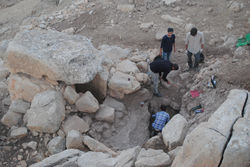Jebel al-Mutawwaq
 |  |  |  |  |
|---|---|---|---|---|
 |
Season 2018
Excavation results of the Spanish-Italian expeditions
The area C East was opened along the Great Enclosure, with a 3x5 m trench opened in the western portion of the structure. The aim was to investigate a megalithic structure (D. 1110) composed by two jambs and a lintel, located along the delimiting wall (W. 101) of the enclosure. It was finally recognized as the main door of the Great Enclosure, accurately closed with a complex sealing system, with a regular curved wall in front of the door and a blocking wall on the back side. Moreover the space between the megalithic door and the blocking walls was filled with layers of stone and compact earth. The complex sealing system of the main western door of the Great Enclosure testify the social and political importance of this structure for the EB IA population of Jebel al-Mutwwaq.
During the 2018 campaign, the excavation in the Area C South, started in 2016, was continued. The 5x5 m area, located in the Southern slope of the site, in correspondence of Dolmen 535, one of the largest megalithic structure since now discovered in the site.
In front of the entrance of the dolmen 535, during 2016 season a floor with an associated circular installation, dated from the materials to EBIB/II, were identified. In 2018 this floor was removed, identifying an underground cave (C.1012), hided by the floor and sealed by filling layers of stone and earth on the entrance and by a blocking wall closing the northern part of the cave.
In the cave several phases of use have been identified and the last one, contemporary to the dolmen and clearly in connection, had a funerary purpose. In this phase three human bones piles were discovered behind the blocking wall, with at least six skulls pushed against the back of the cave, in a similar way of the Bab edh-Dhra EB I shaft tombs. Nevertheless, in association with the disarticulated burials, only miniaturistic vessels were found, dated to the end of the EB I, beginning of the EB II, like the pottery discovered in Dolmen 535 and on the floor sealing the underground cave. This prove definitively the use od Dolmen 535 to decompose bodies in primary position, then taken away from the megalithic chamber to be rearranged in the cave.
Area E was located in the upper part of the mountain and the aim of the 2018 excavation campaign in this area was to investigate a tumulus identified during the surveys conducted in the past years, for the intense presence of ashes suggesting at the beginning the presence of a large furnace. A 5x2 m trench was opened to investigate the structure from the western limit to the central portion of the mound with the aim to understand the building phases of the structure. Since the beginning of the excavation the function of the mound as a furnace was excluded and the possibility of a real function of the mound as a funerary tumulus was explored because of the presence of other tumulus in the site, even if characterized by a different shape and construction technique. During the excavation several pottery sherds which can be dated to an EB IB/II phase were found. The trench did not reach the central zone of the tumulus, that remains to be explored in the future seasons.

Describe your image

Describe your image

Describe your image

Describe your image